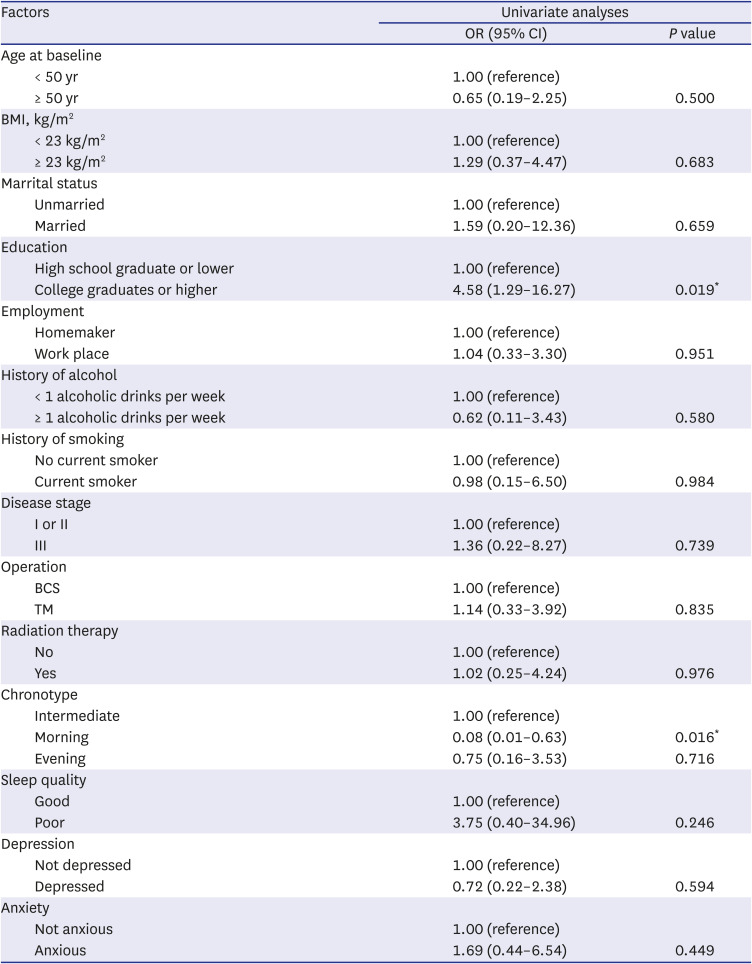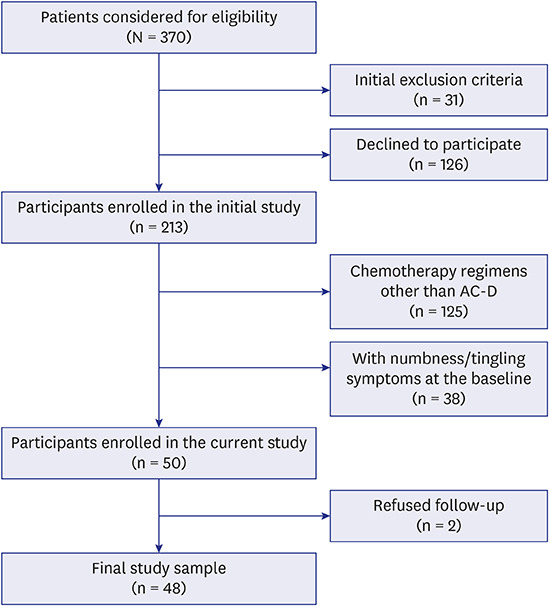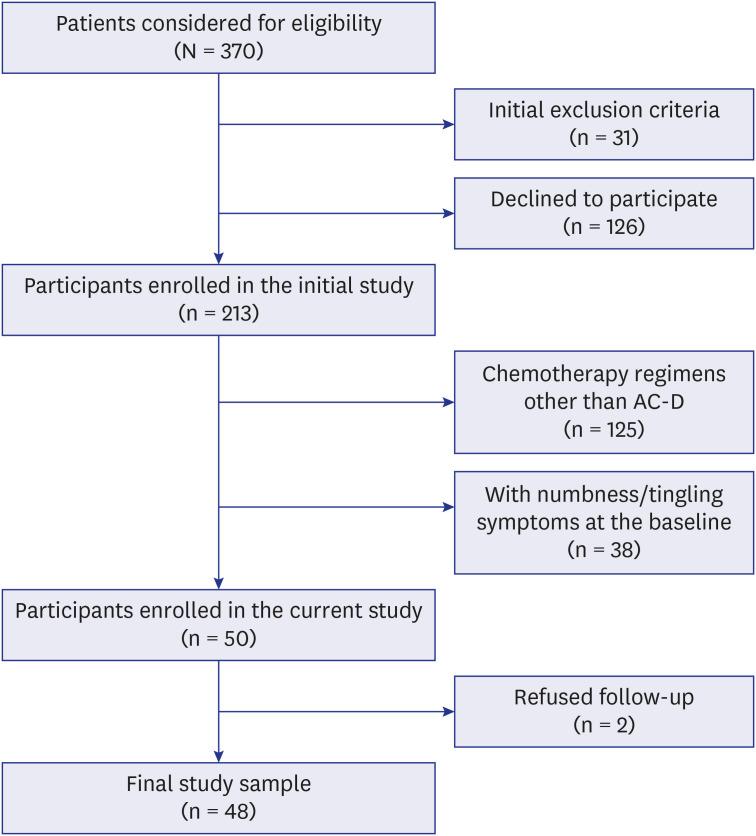1. Phillips JL, Currow DC. Cancer as a chronic disease. Collegian. 2010; 17(2):47–50. PMID:
20738055.

2. Jung KW, Won YJ, Kong HJ, Lee ES. Community of Population-Based Regional Cancer Registries. Cancer statistics in Korea: incidence, mortality, survival, and prevalence in 2015. Cancer Res Treat. 2018; 50(2):303–316. PMID:
29566481.

3. Kerckhove N, Collin A, Condé S, Chaleteix C, Pezet D, Balayssac D. Long-term effects, pathophysiological mechanisms, and risk factors of chemotherapy-induced peripheral neuropathies: a comprehensive literature review. Front Pharmacol. 2017; 8:86. PMID:
28286483.

4. Quasthoff S, Hartung HP. Chemotherapy-induced peripheral neuropathy. J Neurol. 2002; 249(1):9–17. PMID:
11954874.

5. Stubblefield MD, Burstein HJ, Burton AW, Custodio CM, Deng GE, Ho M, et al. NCCN Task Force Report: Management of Neuropathy in Cancer. J Natl Compr Canc Netw. 2009; 7(Suppl 5):S1–26.

6. Wolf S, Barton D, Kottschade L, Grothey A, Loprinzi C. Chemotherapy-induced peripheral neuropathy: prevention and treatment strategies. Eur J Cancer. 2008; 44(11):1507–1515. PMID:
18571399.

7. Lee KM, Jung D, Hwang H, Son KL, Kim TY, Im SA, et al. Pre-treatment anxiety is associated with persistent chemotherapy-induced peripheral neuropathy in women treated with neoadjuvant chemotherapy for breast cancer. J Psychosom Res. 2018; 108:14–19. PMID:
29602320.

8. Jung D, Lee KM, Kim WH, Lee JY, Kim TY, Im SA, et al. Longitudinal association of poor sleep quality with chemotherapy-induced nausea and vomiting in patients with breast cancer. Psychosom Med. 2016; 78(8):959–965. PMID:
27428859.

9. Lee KM, Jung DY, Hwang H, Kim WH, Lee JY, Kim TY, et al. Late chronotypes are associated with neoadjuvant chemotherapy-induced nausea and vomiting in women with breast cancer. Chronobiol Int. 2017; 34(4):480–491. PMID:
28362229.

10. Wittmann M, Dinich J, Merrow M, Roenneberg T. Social jetlag: misalignment of biological and social time. Chronobiol Int. 2006; 23(1-2):497–509. PMID:
16687322.

11. Hahm BJ, Jo B, Dhabhar FS, Palesh O, Aldridge-Gerry A, Bajestan SN, et al. Bedtime misalignment and progression of breast cancer. Chronobiol Int. 2014; 31(2):214–221. PMID:
24156520.

12. Kober KM, Mazor M, Abrams G, Olshen A, Conley YP, Hammer M, et al. Phenotypic characterization of paclitaxel-induced peripheral neuropathy in cancer survivors. J Pain Symptom Manage. 2018; 56(6):908–919.e3. PMID:
30172061.

13. Smith CS, Reilly C, Midkiff K. Evaluation of three circadian rhythm questionnaires with suggestions for an improved measure of morningness. J Appl Psychol. 1989; 74(5):728–738. PMID:
2793773.

14. Bohle P, Tilley AJ, Brown S. Psychometric evaluation of the early/late preferences scale. Ergonomics. 2001; 44(10):887–900. PMID:
11681791.

15. Di Milia L, Wikman R, Smith P. Additional psychometric evidence and construct validity for a revised preferences scale of morningness. Chronobiol Int. 2008; 25(5):776–787. PMID:
18780203.

16. Buysse DJ, Reynolds CF 3rd, Monk TH, Berman SR, Kupfer DJ. The Pittsburgh Sleep Quality Index: a new instrument for psychiatric practice and research. Psychiatry Res. 1989; 28(2):193–213. PMID:
2748771.

17. Carpenter JS, Andrykowski MA. Psychometric evaluation of the Pittsburgh sleep quality index. J Psychosom Res. 1998; 45(1):5–13. PMID:
9720850.

18. Zigmond AS, Snaith RP. The hospital anxiety and depression scale. Acta Psychiatr Scand. 1983; 67(6):361–370. PMID:
6880820.

19. Bjelland I, Dahl AA, Haug TT, Neckelmann D. The validity of the hospital anxiety and depression scale. An updated literature review. J Psychosom Res. 2002; 52(2):69–77. PMID:
11832252.
20. Kerckhove N, Collin A, Condé S, Chaleteix C, Pezet D, Balayssac D. Long-term effects, pathophysiological mechanisms, and risk factors of chemotherapy-induced peripheral neuropathies: a comprehensive literature review. Front Pharmacol. 2017; 8:86. PMID:
28286483.

21. Bao T, Basal C, Seluzicki C, Li SQ, Seidman AD, Mao JJ. Long-term chemotherapy-induced peripheral neuropathy among breast cancer survivors: prevalence, risk factors, and fall risk. Breast Cancer Res Treat. 2016; 159(2):327–333. PMID:
27510185.

22. Johnson CH. Circadian clocks and cell division: what’s the pacemaker? Cell Cycle. 2010; 9(19):3864–3873. PMID:
20890114.
23. Nikaido SS, Johnson CH. Daily and circadian variation in survival from ultraviolet radiation in Chlamydomonas reinhardtii. Photochem Photobiol. 2000; 71(6):758–765. PMID:
10857373.

24. Norma VG, Badrán AF, Barbeito CG. Daily variations in colchicine-induced apoptosis in duodenal crypts. Chronobiol Int. 2005; 22(1):79–88. PMID:
15865323.
25. Adams KL, Castanon-Cervantes O, Evans JA, Davidson AJ. Environmental circadian disruption elevates the IL-6 response to lipopolysaccharide in blood. J Biol Rhythms. 2013; 28(4):272–277. PMID:
23929554.

26. Perry MG, Kirwan JR, Jessop DS, Hunt LP. Overnight variations in cortisol, interleukin 6, tumour necrosis factor alpha and other cytokines in people with rheumatoid arthritis. Ann Rheum Dis. 2009; 68(1):63–68. PMID:
18375536.
27. Kim HK, Lee SY, Koike N, Kim E, Wirianto M, Burish MJ, et al. Circadian regulation of chemotherapy-induced peripheral neuropathic pain and the underlying transcriptomic landscape. Sci Rep. 2020; 10(1):13844. PMID:
32796949.

28. Burish MJ, Chen Z, Yoo SH. Emerging relevance of circadian rhythms in headaches and neuropathic pain. Acta Physiol (Oxf). 2019; 225(1):e13161. PMID:
29969187.

29. Banach M, Juranek JK, Zygulska AL. Chemotherapy-induced neuropathies-a growing problem for patients and health care providers. Brain Behav. 2016; 7(1):e00558. PMID:
28127506.








 PDF
PDF Citation
Citation Print
Print





 XML Download
XML Download